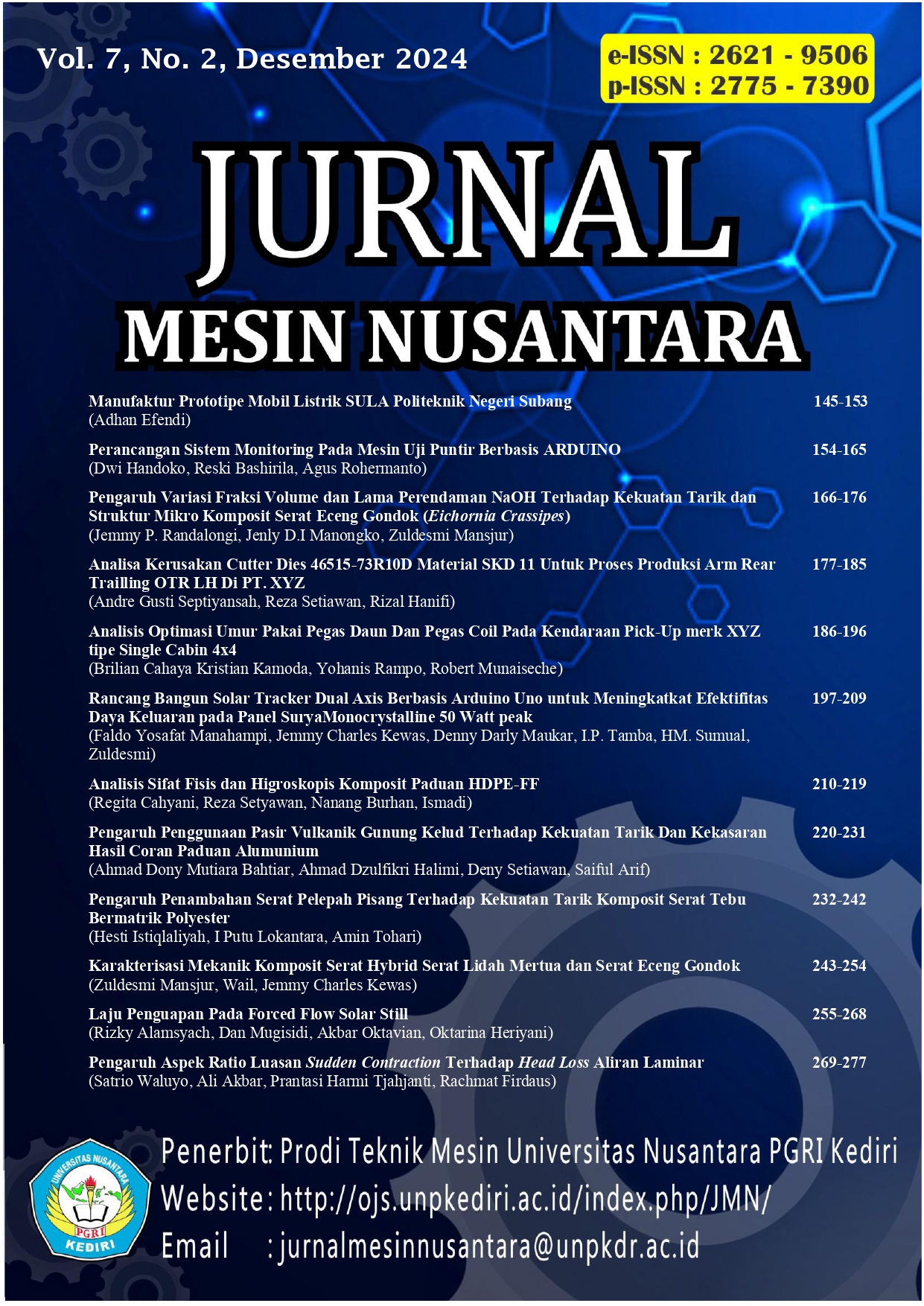Pengaruh Penggunaan Pasir Vulkanik Gunung Kelud Terhadap Kekuatan Tarik Dan Kekasaran Hasil Coran Paduan Alumunium
DOI:
https://doi.org/10.29407/jmn.v7i2.23839Keywords:
Hasil Coran, Paduan Alumunium, Pasir VulkanikAbstract
Muntahan material piroklastik gunung berapi mengandung beberapa deposit berupa batu dan pasir vulkanik yang hingga saat ini ditambangi oleh masyarakat. Pasir vulkanik dengan material piroklastik hasil erupsi Gunung Kelud memiliki sifat unik, yaitu fabrik yang porous dimana partikel dan pengikatnya akan saling mengunci atau tersementasi. Sampai saat ini pemanfaaatan pasir kelud hanya sebatas sebagai material bahan bangunan. Melihat kondisi tersebut, pasir vulkanik Gunung Kelud dimanfaatkan sebagai media cetak proses pengecoran logam terhadap karakteristik permukaan hasil pengecoran khususnya untuk paduan logam alumunium. Metode yang digunakan dalam penelitian ini adalah pengukuran langsung dan analisis citra gambar. Berdasarkan hasil pengujian yang sudah dilaksanakan diperoleh hasil karakteristik coran dengan menggunakan pasir vulkanik tebing gunung kelud mempunyai sifat kekuatan tarik dengan angka tensile strange rata-rata sebesar 65,06 MPa. Sedangkan karakteristik hasil coran dari media pasir puncak didapat di angka 123,26 MPa dibandingkan dengan penggunaan pasir silika biasa karakteristiknya masih tinggi di angka 128,2 MPa. Pada hasil pengujian kekasaran diperoleh permukaan hasil coran pasir vulkanik cenderung lebih sama dengan karakteristik hasil coran dan pasir puncak dimana angka yang didapat berkisar antara 180-187,85, sedangkan penggunaan pasir tebing menghasilkan rata-rata permukaan hasil coran di angka 228,67-234,05. Pada hasil metalografi didapati hasil pengecoran dengan pasir Gunung Kelud masih terdapat porositas yang cukup banyak dibandingkan dengan hasil coran yang menggunakan pasir silika
Downloads
References
A. Zaennudin, “Prakiraan bahaya erupsi Gunung Kelud. Bulletin Vulkanologi Dan Bencana Geologi”, 4(2), 1–17, 2009.
B. D. Collins & N. Sitar, “Geotechnical Properties of Cemented Sands in Steep Slopes.’ Journal of Geotechnical and Geoenvironmental Engineering, ASCE, 2009.
D. O. Latif, A. Rifa’i, & K. B. Suryolelono, “Chemical Characteristics of Volcanic Ash in Indonesia for Soil Stabilization: Morphology and Mineral Content” International Journal of GEOMATE, Vol. 11, Issue 26, Oct., 2016, pp. 2606 – 2016 2610. Geotec. Const. Mat, 2016.
E. Paul DeGarmo, Ronal A. Kohser, 2003, Materials and Processes in Manufacturing, Ninth Edition,John Wiley & Sons, Inc.
Foglio, E.; Gelfi, M.; Pola, A.; Goffelli, S.; Lusuardi, D. Fatigue Characterization and Optimization of the Production Process of Heavy Section Ductile Iron Castings. Int. J. Met. 2017, 11, 33–43.
John R. Newby, 1992, ASTM, Vol 8 Machanical Testing, ASM International , Printed in the United States of America.
Joko Setiono. Pasir Vulkanik Sebagai Stabilitas Campuran Genting Beton. 2004 (Artikel jurnal polinema 10:2004)
Latief, A. Sutowo. 2013. Kajian Tentang Suhu Sinter dan Suhu Lebur Pasir Merapi Sebagai Potensi Sumberdaya Alam yang Mendukung Industri Pengecoran Logam Di Jawa Tengah. Jurnal Ilmiah TEKNIS, 8 (1): 12-15,
N.F. Ismael, “Properties and behavior of cemented sand deposits in Kuwait”, Soils and Foundations, vol. 39, no. 4, 47-57, The Japanese Geotechnical Society, 1999.
N. Sitar, G. W. Clough, R.C. Bachus, “Behavior of Weakly Cemented Soil Slopes Under Static and Seismic Loading Conditions.” United States Geological Survey Department of the Interior, 1980.
Purnadi dan N. Rasidi, Pengaruh Penggantian Pasir Lumajang Dengan Pasir Erupsi Gunung Kelud Terhadap Kualitas Mortar, Jurnal Reka Buana 1 (2015), 25-32.
Hardin, R.A.; Beckermann, C. Integrated Design of Castings: Effect of Porosity on Mechanical Performance. IOP Conf. Ser. Mater. Sci. Eng. 2012, 33, 012069.
A. Hamasaiid, M. S. Dargusch, C. J. Davidson, S. Tovar, Effect of mold coating materials and thickness on heat transfer in permanent mold casting of aluminum alloys, Metallurgical and Materials Transactions A 38(2007) 1303-1316.
Chen Yuping, Metal mold gravity casting process of aluminum alloy castings, Casting Technology (2010)1365-1366.
Sun Hongyun, Actors affecting the tensile testing of metallic materials and operational requirements, Modern Measurement and Laboratory Management 6(2008) 27-29.
T. Jeyapoovan and M. Murugan, “Surface roughness classification using image processing,” Measurement, vol. 46, no. 7, pp. 2065–2072, Aug. 2013, doi: 10.1016/j.measurement.2013.03.014.
E. Gadelmawla, M. Koura, T. Maksoud, I. Elewa, and H. Soliman, “Roughness parameters,” J. Mater. Process. Technol., vol. 123, pp. 133–145, Apr. 2002, doi: 10.1016/S0924-0136(02)00060-2.
M. Thornbush, “Measuring Surface Roughness through the Use of Digital Photography and Image Processing,” Int. J. Geosci., vol. 05, pp. 540–554, Jan. 2014, doi: 10.4236/ijg.2014.55050
Heine, Richard & Loper, Carl & Rosenthal, Philip.1990. Principles of Metal Casting. New Delhi: Tata McGraw- Hill Publishing Company Ltd.
Tiedje, N. S., Taylor, J. A., & Easton, M. A. (2013). A New Multi‐Zone Model For Porosity Distribution In Al‐Si Alloy Castings. Acta Materialia, 61(8), 3037–3049.
Zamani, M. (2015). AlSi Cast Alloys-Microstructure and Mechanical Properties at Ambient and Elevated Temperature (p. 53). Kallered: Ineko AB.
Downloads
Published
Issue
Section
License
Copyright (c) 2024 Ahmad Doni Mutiara Bahtiar, Ahmad Dzulfikri Halimi, Deny Setiawan, Saiful Arif

This work is licensed under a Creative Commons Attribution-ShareAlike 4.0 International License.
Authors who publish with this journal agree to the following terms:
- Copyright on any article is retained by the author(s).
- The author grants the journal, right of first publication with the work simultaneously licensed under a Creative Commons Attribution License that allows others to share the work with an acknowledgment of the work’s authorship and initial publication in this journal.
- Authors are able to enter into separate, additional contractual arrangements for the non-exclusive distribution of the journal’s published version of the work (e.g., post it to an institutional repository or publish it in a book), with an acknowledgment of its initial publication in this journal.
- Authors are permitted and encouraged to post their work online (e.g., in institutional repositories or on their website) prior to and during the submission process, as it can lead to productive exchanges, as well as earlier and greater citation of published work.
- The article and any associated published material is distributed under the Creative Commons Attribution-ShareAlike 4.0 International License












